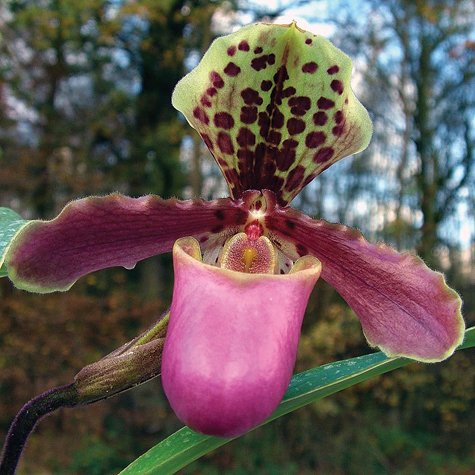GARDENER'S NOTEBOOK

Tropical Lady Slippers
By Mariko Kawaguchi
The Vineyard windowsill in winter lacks the blooms in contrast to our offerings during our active lifestyles in the summer. Winter holidays are past, trimmings are put back in the attic and the pursuit of hope and rebirth await the return of longer days and extended sunlight of springtime. The diva of my indoor garden is my favorite orchid genus. Paphiopedilum aka the tropical ladyslipper, (abbreviated, orchidphiles refer to them as ‘Paphs’). Bold and sculptural these botanical flowers rebel against the fluffy, stereotypical 1940's style corsage, the preconceived notion of ours, that what an orchid is. Tropical ladyslippers are the best friends to a New England window. They are in my opinion the easiest orchid to cultivate in one's home. They are great companions to begonias, African violets and ivys.
Recently I was asked if paph’s were an immediate favorite of mine when I first entered the world of orchids, while I would like to say yes, the truth is I was more enamored by the bold exotic colors, fragrances and rarity of the more familiar plants in the orchid kingdom. It took awhile for my interest to paphs as their extremely unique shape and structure were like no other flowers in my comprehension. The unique shaped paph grabbed my attention and has held my interest for decades.
The word paphiopedilum is derived from the Greek words Paphos (a city with a temple dedicated to Venus) and pedilon (sandal or slipper). According to ancient Greek myth, Aphrodite was born out of the sea and landed at the site of Paphos, in what is now the Island of Cyprus, where a great temple was built in her honor. This orchid’s shape and beauty would have made it a suitable slipper for the goddess of love; hence it was named paphiopedilum.
As cypripediums, phragmipediums and selenipediums are popularly known as ‘lady’s slippers’, so too are paphs since they are all characterized by a slipper-shaped lip. Rather than growing from a pseudobulb, these mostly terrestrial, sympodial plants instead form fans of six or more leaves. Depending on the species, the flowers are borne either singularly or in multiples. A curious insect will be attracted to the flower of certain paphs, and will end up falling inside and can only get out of the plant by climbing up the back wall of the pouch which contain tiny hairs providing a stairway the insect can climb to get out. However it must pass through pollen to escape, which it will then carry away and be used to pollinate another paph. It is a highly developed mechanism that ensures the success of the plant. Plant lovers delight in the knowledge that the flower is simply a lurant for the pollinator in the dance of reproduction the plant uses to move its pollen to produce seed.
Recently I was asked if paph’s were an immediate favorite of mine when I first entered the world of orchids, while I would like to say yes, the truth is I was more enamored by the bold exotic colors, fragrances and rarity of the more familiar plants in the orchid kingdom. It took awhile for my interest to paphs as their extremely unique shape and structure were like no other flowers in my comprehension. The unique shaped paph grabbed my attention and has held my interest for decades.
The word paphiopedilum is derived from the Greek words Paphos (a city with a temple dedicated to Venus) and pedilon (sandal or slipper). According to ancient Greek myth, Aphrodite was born out of the sea and landed at the site of Paphos, in what is now the Island of Cyprus, where a great temple was built in her honor. This orchid’s shape and beauty would have made it a suitable slipper for the goddess of love; hence it was named paphiopedilum.
As cypripediums, phragmipediums and selenipediums are popularly known as ‘lady’s slippers’, so too are paphs since they are all characterized by a slipper-shaped lip. Rather than growing from a pseudobulb, these mostly terrestrial, sympodial plants instead form fans of six or more leaves. Depending on the species, the flowers are borne either singularly or in multiples. A curious insect will be attracted to the flower of certain paphs, and will end up falling inside and can only get out of the plant by climbing up the back wall of the pouch which contain tiny hairs providing a stairway the insect can climb to get out. However it must pass through pollen to escape, which it will then carry away and be used to pollinate another paph. It is a highly developed mechanism that ensures the success of the plant. Plant lovers delight in the knowledge that the flower is simply a lurant for the pollinator in the dance of reproduction the plant uses to move its pollen to produce seed.








